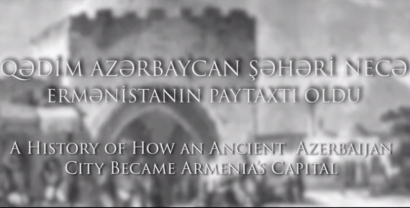A History of How an Ancient Azerbaijan City Became Armenian Capital

The Azerbaijan State Translation Centre (AzSTC) has produced a documentary archival video footage “A History of How an Ancient Azerbaijan City Became Armenian Capital” about the modern Yerevan, formerly known as Irevan, capital of Armenia that features the ancient history of Irevan city, the Armenians resettling in these territories after the occupation in 1827 and expel of local population – Azerbaijanis with help of the military units in Tsarist Russia.
AzSTC has sent the video footage with subtitles in various languages to accredited foreign embassies to the Republic of Azerbaijan, as well as distributed among influential global mass media.
Modern Yerevan, formerly known as Irevan, capital of Armenia, is situated in a pleasant and spacious area on the Zengi River, which forms the Aghri (Ararat) Plain. Yerevan is a distorted form of “Ravan” and “Irevan”, toponyms found in geographically referenced statistics. According to many scientific studies on ancient Irevan and its history, the toponym “Irevan” is said to derive from a blend of native Turkic words “ir” or “ər” (man or brave man) and “avan” (country, village or city’) meaning “A Land of the Braves”. Dozens of castles, gates, squares, quarters, markets, mosques, caravanserais, baths, and springs with Azerbaijani toponyms are said to have been registered in this area between the 16th and 19th centuries.
According to Evliya Chelebi, a famous Turkish traveller and geographer, the fortress was built in 1509 by the founder of the Safavid dynasty Shah Ismail for his vizier Ravangulu khan, as a strategically important fortress to protect the city from foreign invaders. The fortress was called “Ravan” (also “Irevan” in spoken language) named for his vizier.
According to some historical sources, there were 43 rulers - khans, sardars, beylerbeks in Yerevan and around it before the occupation of the Irevan Khanate by tsarist Russia in 1827. No names or family names of Armenian origin were mentioned in 1590- 1728 statistical reports on the demographic situation in the city but indicating more than 90 percent of its population were Azerbaijani Turks. Other archival data for the period also reveal that along with the families of four khans, 41 beys, 50 akhunds and mullahs, there were eight priest families of Christian confession in the city.
Famous French traveller Jean Chardin (born Jean-Baptiste Chardin, and also known as Sir John Chardin) (1643–1711), who spent several years of his life in Azerbaijan and Iran, described the 1627 view of the Irevan fortress as following: “The castle consists of eight hundred houses. Only pureblood Kyzylbashs (Azerbaijanis) live there. The Safavids observe numerous religious and folk holidays. And the history of religious rites and major religious events, as well as the days that mark the change of seasons, are sacred to them. However, three religious holidays are celebrated and preserved as a tradition. The Safavids celebrate the holiday of Ramadan the next day as soon as the month ends. The day of the martyrdom of Ibrahim and the followers of Ali on the religious path is sadly marked here. New Year is also celebrated here although it is not designated as a national holiday. It should be noted that the Novruz holiday lasts for three days. In other places, as in the palace, this holiday lasts until the eighth day, when the Sun enters the sign of Aries. This holiday is called Novruz Sultaniyye meaning “Magnificent New Year” or “New Year of the Empire”.”
The original version of Jean Chardin’s “Travels in Persia” remains to this day at The Bibliothèque nationale de France (The National Library of France).
Stepan Pavlovich Zelinsky, one of the profound opening researchers of history of Yerevan, wrote a series of articles on the topic, published in the first issue of the “Collection of Materials for the Description of the Localities and Tribes of the Caucasus” in 1881. Some of his articles, such as Irevan City, Derechichek, Tatar proverbs, parables, riddles and female names and Ethnographic Essays on the Life of Immigrants from Iran Who settled in the Nakhchivan Region of the Irevan Province discover a lot of facts about Irevan and its surrounding areas.
Concerning the city’s seven residential areas that had Azerbaijani names, the author, for example, states that “along with Azerbaijanis in the urban areas of Tepebashi, Shahar, Khanlygbag, Demirbulaq and Derekend there lived a small number of Molokans who had settled in Yerevan at that time. After the Turkmenchay Peace Treaty, Cholmagchi, resettled by Armenians from Iran and Turkey, was renamed to Nortskiy.”
And as a result of the impact betrayed by Armenians who settled in Yerevan in 1827 under the command of General of the Russian Army Ivan Fedorovich Paskevich (1782-1856), the crescent moons were removed from city mosques, including the mosque built in 1725 by the Ottoman commander Rajab Pasha, and were replaced with crosses. And mosque towers were replaced with church bells. In the same year, for this operation, the Russian Tsar Nicholai I awarded Ivan Paskevich the title of “Count of Irevan”, after which the 'Armenian province' was created, covering the territory of Nakhchivan and the Irevan Khanates of Azerbaijan.
After the occupation of the city, a large part of the local population was forced to move to Iran and Turkey to avoid persecution, torture and murder by military forces and Armenians living in the city.
Despite all this, all documents on demographic statistics conducted by the registration organizations of Tsarist Russia in the city of Yerevan in 1829, 1880 and 1917 showed that the number of Armenians in the city was still much less than that of Azerbaijanis.
The Azerbaijan Democratic Republic that proclaimed its independence on May 28, 1918 made a decision to transfer the city of Yerevan to the newly formed Republic of Armenia as its capital. However, this benevolent step of the Azerbaijani state did not pacify the Armenians’ invincible land and territorial ambitions. In the two years since Yerevan was declared the capital of Armenia, more than 50,000 civilians had been brutally killed in bloody wars across ancient territories of Azerbaijan, such as Nakhchivan, Zangazur and Garabagh, with more than 300 cities, villages and settlements destroyed, sacked and looted.
With its terrible aggressive policy, the Soviet Republic of Armenia whose territory was 9,000 square kilometres succeeded in having an expanded area of about 29,743 square kilometres on May 29, 1918.
AND OTHER...
-
 Book “Fuzuli’s Creativity” by Mir Jalal Out in Jordan
Book “Fuzuli’s Creativity” by Mir Jalal Out in Jordan
The book “Fuzuli’s Creativity” by the famous Azerbaijani writer and literary scholar Mir Jalal, which tells about the works of the brilliant Azerbaijani poet...
-
 Yusif Vazir Chamanzaminli’s Creativity in the Israeli Literary Magazine
Yusif Vazir Chamanzaminli’s Creativity in the Israeli Literary Magazine
“Artikl”, the popular Israeli literary magazine, has posted in Russian an excerpt from the novel “In the Crossfire” by Yusif Vazir Chamanzaminli, the outstanding...









